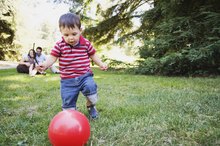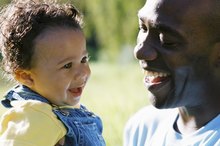Hand Clapping Games for Toddlers
Older kids play intricate clapping games along with songs, but even young toddlers are able to participate in simple activities that involve clapping 1. The hand-clapping games and activities work well in group situations like day care or at home with a parent and child. Younger toddlers may need help with clapping, while older toddlers catch on quickly and clap on their own.
Clap for Development
Most babies learn to clap their hands between 9 months and 1 year of age. By the toddler years, most children are able to clap. The clapping games and activities help toddlers further develop control of their muscles and hand-eye coordination 1. The games also help young children learn about rhythm and control of their bodies. The activities often integrate singing or a combination of actions for further development of body control and coordination.
- Most babies learn to clap their hands between 9 months and 1 year of age.
- The clapping games and activities help toddlers further develop control of their muscles and hand-eye coordination 1.
Clap to the Rhythm
Galloping Activities for Children
Learn More
Clapping out rhythm patterns helps toddlers improve their coordination and listening skills. Hold a small drum or clap out a simple pattern with your hands and have your youngster follow the pattern. Start over, adding a few more claps. Continue adding more to the clapping pattern. When hosting a toddler play date, turn over the drum to your toddler so he is able to drum out a clapping pattern for the other kids.
- Clapping out rhythm patterns helps toddlers improve their coordination and listening skills.
- When hosting a toddler play date, turn over the drum to your toddler so he is able to drum out a clapping pattern for the other kids.
Clap and Sing
Many songs appropriate for the toddler age group involve clapping. Three common songs are "If You're Happy and You Know It," "Bingo" and "Patty Cake." The "Hokey Pokey" is a game that involves clapping during the main verse of the song. The familiarity of these songs makes it easier for toddlers to clap along in the appropriate places. Another option is to make up your own songs that involve clapping or add claps into other familiar kids' songs your toddler knows. Clap along with the beat of simple toddler songs and rhymes like "Humpty Dumpty" or "Three Blind Mice."
- Many songs appropriate for the toddler age group involve clapping.
- Another option is to make up your own songs that involve clapping or add claps into other familiar kids' songs your toddler knows.
Break it Down and Be Creative
Activities to Promote Perceptual & Motor Skills
Learn More
Demonstrate the clapping activity first so your toddler gets an idea of what she's doing. If the activity involves multiple actions or intricate clapping patterns, break it down into smaller steps. Teach her each step individually, then put it together for the song or game. Encourage your child to come up with her own variations or clapping activities. This encourages her cognitive skills and creativity in addition to the physical coordination benefits of clapping activities.
- Demonstrate the clapping activity first so your toddler gets an idea of what she's doing.
Related Articles
References
Writer Bio
Based in the Midwest, Shelley Frost has been writing parenting and education articles since 2007. Her experience comes from teaching, tutoring and managing educational after school programs. Frost worked in insurance and software testing before becoming a writer. She holds a Bachelor of Arts in elementary education with a reading endorsement.








